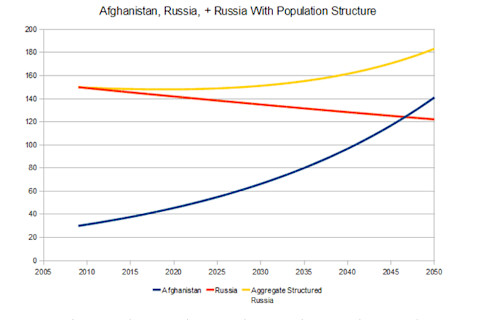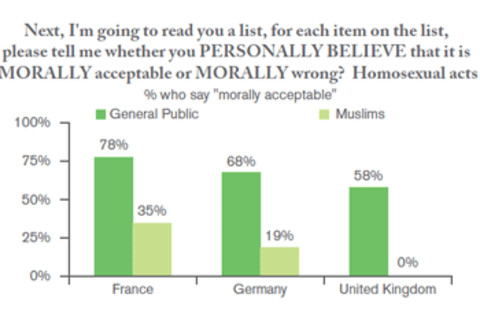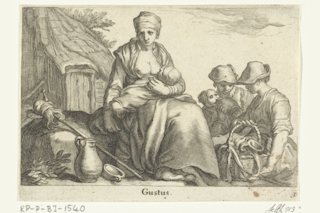
About six months ago I read a history of modern Italy and was struck by a passage which observed that during the early years of the Italian state none of the prominent political leaders were practicing Roman Catholics. Part of this was specific to the history of the rise of modern Italy, Umberto I fought the Papacy, and so alienated the institution of the Church from the royal house and the state over which it ruled. But more generally many of the nationalists of the 19th century in Catholic Europe were of an anti-clerical bent. Only with the reconciliation of the Roman Catholic Church with the modern liberal democratic nation-state in the 20th century, and universal suffrage, have the political elites come to resemble the populace more in their religious sensibilities in these nations. And before you dismiss this as a European matter, observe that Andrew Jackson, our sixth president, was the first to have personal religious views in line with the American majority. As late as William Howard Taft in the early 20th century the United States had a head of state who rejected orthodox Christianity (he was a Unitarian Christian). Can we imagine that such a thing would come to pass without much controversy today? Mitt Romney has famously had to elide the yawning chasm between Mormonism and Nicene Christianity to be a viable candidate. The point I'm trying to make here is that the paths of the arrows of history are more complex than we perceive them in our own moment in time. It is ironic that we in the United States are living through a period of secularization at the grassroots, while at the same time having to deal with the fact that all high level politicians have to pass through a de factoreligious litmus test of relatively stringent orthodoxy. The complexity of this sort of social phenomenon makes it exceedingly difficult to analyze and characterize in a pithy fashion. Too often when scholars and intellectuals speak of the history of religion they impose their own visions on the flux of human belief and behavior. Eric Kaufmann's Shall the Religious Inherit the Earth is not such an argument. Rather, it is a cautious work which makes recourse to both robust theoretical models as well as a wide and rich set of empirical data. Kaufmann casts a very wide net in his attempt to retrieve a useful catch in terms of plausible and robust predictions. The central idea of the book is derived from the fact that the endogenous growth rates of religious segments of developed societies can often be rather high. The broader implication is that history moves in cycles, and that the current age of secularism is nearing its peak, and inevitable demographic forces will see the tide retreat. As indicated above Eric Kaufmann does not simply present one with qualitative verbal arguments, he actually goes over the projections of quantitative models which his research team generated! In this area this is gold, for pure conjecture and speculation tend to abound. But Shall the Religious Inherit the Earth is not purely a theoretical treatise, it is rich with thick empirical data and references the broader literature. Eric Kaufmann is not sloppy with detail, and tends to couch assertions carefully. Unlike many who have a thesis he does not ignore or mitigate trends which go in the opposite direction of his broader argument. He admits, for example, that secularization continues in some regions of the world; in particular the United States, Southern Europe, and southern Latin America. There may even be some juice left in secularization in Northern Europe as the older generations which fill the pews die off to be replaced by the cresting wave of irreligious born since 1960. He also admits that societies which have gone through secularization have not swung back to irrevocable religiosity. For example, France in the early 19th century was characterized by a situation of highly fecund Catholic immigrants arriving to reinforce the conservative Catholic faction among the native-born. And yet nearly two centuries later France is as secular as ever, and in fact getting more secular. These caveats aside, the demographic parameters of growth and decline do significantly shape the destiny of the future. In regions such as Bosnia, Northern Ireland and the Netherlands the religious makeup of a society has slowly shifted purely through differences of fertility. This has had long term social-political consequences of varying degrees. This is not speculation or prediction, rather, we know the present conditions, and can see the hand of demography shaping the path of the past. His attention to specific details and their nuance is where Kaufmann wins my respect. He notes that the seemingly inevitable Catholic ascendancy in the Netherlands was never to be, because that sect experienced the same collapse in popular support which the mainstream Reformed Church did a generation before. The parameters of demographic destiny can be quite variable, so the details must always been approached with caution. Similarly, the fertility gap between Catholics and Protestants in Northern Ireland has closed, so the likely inevitable shift to a Catholic majority has slowed to a crawl and is only proceeding by demographic inertia. The long-term winners of the demographic game may not always be who we perceive to be most salient in the present, as engines of activity bubble underneath the radar. The outline of Shall the Religious Inherit the Earth is simple. A few initial general chapters lay out the parameters, probabilities, and projections. Then a series of specific sections focus on particular regions; the USA, the Islamic world, Europe, and Israel. Finally Eric Kaufmann reviews the general outline of his thesis, its implications for secular people, of whom he is one, and the caveats that must be made. In a nutshell, here's the power of endogenous growth.

Russia currently has a -0.50% growth rate, while Afghanistan has a 3.85% growth rate. Projecting outward on a yearly basis and you see the power of compounding. Assuming current rates of growth (or shrinkage) the two nations will cross paths sometime in the year 2050. Do I believe that that will come to pass? No. There's no reason that these growth rates have to stay constant. I believe Afghanistan's will decrease, while Russia's will increase. In the former case I don't think Afghanistan's Human Development Index could get any lower, so I think fertility is going to go down almost as an iron law of modern existence. For Russia, fertility collapsed relatively recently, so it may bounce back with a cultural change. Also, there are likely more fertile minorities within Russia would will bring back median fertility. Let's use a toy example to illustrate what I'm alluding to here. Imagine that 10% of Russian citizens are very fertile. If a nation of their own they'd have growth rates of 5% per year. In contrast 90% of Russians have a negative population growth rate of -0.6% per year. This produces about -0.50% per year when you weight by population for Russia as a whole, what we have right now. Let's take the projections from the first chart, and add a new value for Russia which consists of the total population assuming these two sub-Russias are viewed as distinct populations. In other words, they don't intermarry, and continue at their current pace of population growth.

So what happened? The new scenario for Russia still has population decline for the next 20 years, but eventually it stops and reverses. That's because of the subsegment within the Russian population which is fertile keeps increase its proportion, and the aggregate rate of change shifts along with that. In fact, projecting outwards, in 2109 the fertile Russian group will be 94% of the population of Russia, as opposed to 10% in 2009. Because they're the preponderance of Russia's population in this toy model Russia they're actually outpacing Afghanistan by then. I wanted to show you a very simple toy model to give a good sense of the power of endogenous population growth and projection. This is the core axiom at the heart of Shall the Religious Inherit the Earth. Demography influences destiny. I say influence because as Kaufmann himself will admit, and I always want to emphasize, fertility differences between populations can invert. In the 19th century in Rumelia, the Balkan regions under Ottoman rule, Christians had higher fertility than Muslims. Today the situation is very different. Some historical scholarship indicates that until very recently what we know of as Bosnia actually consisted of two populations, Muslims and Catholics, whose dialect of South Slav was more similar to Croatia than Serbia. The rise of Bosnian Serbs may then have been a function of migration due to population growth in Serbia proper. The subsequent conflict in the Balkans can be traced to Serb fears of Muslim hegemony in a nation in which that element became a larger and larger fraction due to higher fertility. Before we move to specifics, a few general trends highlighted in Shall the Religious Inherit the Earth. First, the simple one: the highly fertile religious nations are waxing in population, while secular regions are stagnant, or even in decline. In general Europe and European dominated societies are in the second class, along with East Asia. Basically the two regions of the world which most people reading this weblog would consider at an advanced state of modernity. In contrast, in the Islamic world, and in the more religious nations of Latin America (exclude the southern cone), Africa, and South Asia, secularism is weak as a mass phenomenon (though it has some purchase among elites in Latin America and India), and fertility is still high. Even in nations which are now sub-replacement, such as Iran, will grow in population because of demographic inertia. The young have not entered their peak childbearing years. Here are some examples: Of course one can imagine that secularization will kick in in these societies at some point. But generally there needs to be a particular level of development, and in many of these nations it will be a very long haul indeed. If we're taking about the scale of 2-3 generations it seems plausible that the proportion of atheists and agnostics in the world will decline as East Asia and Europe become a smaller and smaller fraction, and secularization does not immediately initiate in developing world. Examples of "snap secularization," where societies go from being very religious to very secular in a decade or so, like Quebec, seem to have a bit of affluence under their belt (Spain today may be an example of this). Eric Kaufmann has a specific thesis as to how modern secularization occurs: as societies develop nominal believers in religious societies eventually fall away. In Saudi Arabia, or Thailand, the connection between religion, culture, and nationality, is such that there are vast numbers of people who are affiliated and religious, but who don't have any strong individual drive to be so. Rather, in their particular social environment some level of religiosity is the only option. Also, in the high fertility fraction of these societies there does not seem to be much fertility difference between the more and less religious. Rather, the fertility difference becomes stark once a society goes through demographic transition, and having children becomes a discretionary choice, rather than an expectation. The choice seems to be made in particular by individuals affiliated with strongly communitarian religious groups. In the United States the fertility differences between religious groups can be stark. Muslims have a TFR of 2.84, while Jews have one of 1.43. The long term consequences of these between group differences are obviously interesting, but I believe that the more important data in Shall the Religious Inherit the Earth is the documentation of within group differences. Aggregate Jewish fertility is low, below the 2.08 natural average. But Orthodox Jews are above the national average, while "ultra-Orthodox" (haredi) Jews are two to three times the national average! While the generic conservative white Protestant TFR is 2.13, there is a core group of radical conservative Protestants who have a TFR of above 2.5. Small sects such as Foursquare Gospel have Mormon-like rates of fertility. While the average American Catholic is around the same fertility as the non-Catholic, conservative traditionalist Catholics are much more fertile. Antonin Scalia has nine children. Because of the relatively advanced state of the world Ashkenazi Jewry some of Eric Kaufmann's predictions seem to be especially born out in them. Haredi Jews are the most 'conservative' of Orthodox Jews. We gentiles would probably recognize them as the Jews who 'dress weird.' The Hasidic communities are famous, but there are also non-Hasidic Haredi Jewish groups. In Britain the Haredim are 17 percent of the Jewish community. But shockingly they're currently 75% of the births currently in Britain to Jews! Kaufmann also claims that the Haredi are now ~10% of American Jews in 2010, which would mean that the Orthodox as a whole are now gaining. The patterns in Israel are also striking, though more complex. Israel is on of the world's most ethnically diverse societies, with broad ethno-national categories of Ashkenazim, Mizrahim, and Sephardim, though even within these categories there is variation. In addition to this, there are divisions between secular Jews, religious, but not strictly Orthodox Jews, Orthodox Jews of a modern bent, and finally, the Haredi. In this framework arguably the Ashkenazi are bimodal, concentrated among the secular and Haredi segments, while the non-Ashkenazi Jews tend to be religious, but not hyper-observant. On top of this there are also hyper-secular Russian Jews, many of whom are only partly Jewish in origin, as well as the non-Jewish minorities, mostly Arabs. In 1960 15 percent of elementary age students in Israel were Arab or Haredi. In 2010 ~50% are.
It is because of the Haredi that Israel does not face an immediate demographic crisis as a Jewish state:
...In 2001, there were around 95,000 Jewish births in Israel and 41,000 Arab births. Just seven years later, in 2008, Jewish births had risen to over 117,000, but Arab births had declined to less than 40,000. In a period that constitutes barely a quarter of a generation, Arab births had fallen from around 30 percent of the total to around 25 percent. This has been a steady trend and, should it continue, it will only be a very short time before Jewish and Arab births each year are broadly proportionate to the overall balance of Jews and Arabs in the population as whole - that is, 4:1, or 80 percent and 20 percent, respectively.
The Haredi fertility is stable, somewhere in the 6-10 TFR range depending on the community, while Arab TFR has dropped to 4 or below. Interestingly the secular Jewish TFR has also increased in the past generation, from 2.1 to 2.6. This is a reminder to be very careful of average values of fertility for a group. It seems that for ideological or cultural reasons the Haredi in Israel remain fertile, even after allowances for children were cut back, which had an immediate effect on Arab fertility. The lower Jewish aggregate fertility ignores the motive force of the Haredi within the larger community. Assuming current trends the Haredi will likely become the majority within Israel by about 2050. Shifting to Europe, the same dynamic may be at play. It is well known that much of Europe has a Muslim minority, though perhaps less well known that Russia has a larger proportion than any Western European nation, at ~10-15%. In the European Union as a whole the total number of Muslims is on the order of ~5%, and this includes traditionally Muslim groups in the Balkans (Slavs, Albanians, and Turks). But the key is the future. Kaufmann assembled data from nations where there was information on fertility changes by religion, migration rates, etc. Here are some numbers for Western European nations:

Some of this is not too surprising. The problem in the area of statistics about Muslims in Europe is that ignorance, fear, and stupidity is rife. As someone with an aversion and dislike for Islam in particular of all the higher religions I have been known to be susceptible to that tendency. But the reality is that Islamic populations are modest, but very concentrated, in much of Europe. So, for example the fact that in Rotterdam the majority of births may be to Muslims is conflated with the fact that the majority of births in the Netherlands will be to Muslims! Americans who travel to Europe and visit Amsterdam, London, and Paris, may get a very skewed view as to the ethnic diversity of Europe. Even then, London, that most diverse of cities, is actually about as white as the United States as a whole. There are several parameters which will influence Islam in the future. Primarily, intermarriage, conversion & defection, immigration, and fertility. Outside of the French Muslim community intermarriage with non-Muslims is low in Western Europe. This is in contrast to traditionally Christian groups; more than 50% of second generation black Britons intermarry, vs. less than 10% of Muslims (though the number for South Asian non-Muslims is nearly as low). Though there are prominent instances of conversion, the reality is that numerically they are few and far between. Though outright defection to Christianity or other religions seems uncommon, in part because of social ostracism from the community, in some regions secularization is common (e.g., France). Finally, there is immigration and fertility. Some of the source nations of Muslims to Europe, such as Turkey and Algeria, are near replacement or sub-replacement in fertility. Additionally, even though European social benefits are generous, one could assert that Turkey presents a more favorable medium-to-long-term prospect in terms of labor opportunities than Germany for a Turk. With the likely curtailment of the most generous aspects of the European welfare state in the age of austerity one presumes that that magnet for immigration will be less powerful. Finally, there is the issue of fertility. Here there is wide variance, with very fertile South Asians and Somalis, and far less fertile North Africans and Turks. The source nation of the ethnic group seems to matter quite a bit. Nevertheless, there are two factors to highlight here. First, there is almost always a gap in fertility between Muslims and non-Muslims. In the German-speaking world and Italy the fertility of non-Muslim populations (excluding Roma) is so low that even modestly fecund Muslim minorities have a great advantage. Second, Muslim fertility rates do tend to converge with non-Muslim ones after a few generations.

The assumptions in the model: - Convergence between Muslim and non-Muslim fertility by 2050 - The same rates of immigration between now and 2050 - No secularization for Muslims between now and 2050 None of these are realistic assumptions, but the deviation from reality of the first would have the opposite effect as the latter ones. That is, fertility will probably not totally converge, but it is also likely that some secularization will occur, and that immigration rates may decrease because of the global demographic transition. Taking the projections further the models indicate that the Muslim proportion of Europe will stabilize at around ~20% by the second half the 21st century. I find it interesting that Sweden may have the highest fractions of Muslims in Europe in my lifetime, excluding areas with traditional Muslim majorities (Albania), or large minorities (Macedonia, Bulgaria, etc.). Perhaps by 2050 a "Swedish Burqa Team" will be more appropriate than a "Swedish Bikini Team."?

The exception in Europe in regards to the Muslim vs. non-Muslim gap is France. This has long been evident to me in the survey data. French "Muslims" are more religious and fertile than French non-Muslims, but the gap is far smaller than between British Muslims and non-Muslims. The figure to the left is from The Gallup Coexist Index 2009. It's immediately evident that though French Muslims are far less gay friendly than the French public as a whole, the gap between them and the broader society is far smaller than between British Muslims and the British in general. Literally 0% of British Muslims believe that homosexuality is morally acceptable. I guess the British can take pride in their multicultural society, which has allowed for diverse values to flourish. In any case Eric Kaufmann argues that there's a relatively understandable reason why French Muslims are more integrated than their co-religionists in Britain and Germany. It isn't because of France's ideological demand that immigrants assimilate to "French culture." Rather, he points out that a disproportionate number of French Muslims, the majority, are of North African origin, and that North Africa has a relatively large secular population in relation to the rest of the Muslim world. Additionally, a disproportionate number of North Africans in France are of Kabyle Berber stock. This non-Arab minority in Algeria has long been subject to discrimination from the Arab majority, especially in the nationalistic era. In response Kabyle intellectuals have espoused an aggressive separatist identity, which has pushed Islam somewhat to the side because of its association with the Arab conquest and the Arab majority. Though Muslims, I believe one would see the same trend with the Alevi Turkish Muslims in Germany, who are reputedly more open to assimilating into German society. A group which has been persecuted and marginalized in Turkey itself by the Sunni majority, it seems plausible that the Alevi Turks have a less strong attachment to a separate identity as Turks because of their fraught history. But what about the presumed Christian majority? European societies have been traditionally Christian, and today are nominally so. In nations like Finland most people are members of the national church, but it is an expression of their national identity, not their belief in the truth claims around which the institution was built. In other words state-sponsored Scandinavian Lutheranism is rather like a facade, with all the trappings of outward religion, but generally lacking in substantive dynamism. But there are exceptions to this in all European societies where a lax and nominal majority is ascendant. In Finland there is a branch of the sectarian Laestadian Lutherans. Their fertility is awesome. In the 1980s while the TFR of the majority Finnish Lutherans was 1.5, that of the Laestadians was 5.5. I met an individual whose family was from the Laestadian tradition last spring. Though he himself is not a religious believer at all, I was struck by the fact that he and his wife (also irreligious) were enthusiastic about the prospect of having a rather large family, definitely above replacement. In the United States such a sanguine attitude toward family planning, and pro-natalist enthusiasm, is pretty much unknown among secular professionals of my acquaintance. In contrast, in Italy the whole society is strongly skeptical of the sustainability of large families in terms of maintaining levels of individual affluence, though they are rather ill-at-ease with the importation of West African, Filipino, and Bangaldeshi servitor castes. These sorts of within society fissures and divisions lead us to consider the wide gap in fertility and religiosity which has now emerged in Western developed societies. Eric Kaufmann points out that it is precisely in these secularized developed nations that the correlation between religiosity and fertility is strongest. The religious invest their surplus economic productivity in children in a classic Malthusian manner. Secular and moderately religious folk tend to practice family planning, and many have delayed child-bearing so long that they will not replace themselves (being childless or only having one child). It is in the wake of the first demographic transition that Eric Kaufmann believes a second demographic transition will emerge. The cultural and social realities which enjoined high fertility in the pre-modern world no longer hold. Now that people may choose when to have children, many choose not to. Those who choose to have children do so for ideological and normative reasons. The natural inference then is that the correlation between values and fertility is driving rapid cultural evolution in these societies. From all the data surveyed it seems that Israel is the nation which is closest to the second demographic transition. In many ways it is a peculiar nation. Though the Haredi are the primary vehicles of the Jewish demographic renaissance, they are also famously less economically productive on a per unit basis than non-Haredi Israelis. They also tend to avoid national military service at much higher rates than the rest of the Jewish population. It is clear that in some ways Israel is facing a crisis of national identity because of the demographic decline of its core Zionist ethnos, the secular Ashkenazi Jew. These are the intellectuals, politicians, and military officers of the Israel state. But if current trends pan out, by 2050 Haredi Jews will be a majority of Israel's population. If that is so then without a massive gain in per capita human economic productivity the Israeli state will not be able to subsidize the scholarly pursuits of many Haredi men. Between then and now a social revolution of some sort is inevitable. Details to be worked out. But 2050 is a long way away. How much of 2010 could you predict from 1970? In general I have to admit that I skip over projections of the year 2100. On the other hand, projections of the year 2030 are of great interest, as a 20 year window seems small enough that trends would be robust enough to absorb any shocks. 2050 is a gray point for me, I'm generally skeptical, but don't think that such projections can be dismissed out of hand. But the details matter. Kaufmann quotes some scholars who assert that ~20% of Americans will be of mixed racial heritage heritage by then as defined by the Census. Depending on how these individuals classify themselves, and how society views them, will turn the answer to the question of whether the USA will be majority non-white in 2050. Trends can change very quickly, as can their interpretations. The author admits that an "optimistic" scenario, from his perspective as a liberal secular Westerner, is of equilibration. That the fecund religious will birth the future generations of secularists. In some ways this has been occurring for a few centuries now, starting with the first explicit and public anti-clericalists who came to the fore during the French Revolutionary regime. In Kaufmann's own data set he shows that secular Dutch women were below replacement before World War II. And yet Dutch society as a whole went through massive secularization after World War II. The point here is that even though religion is heritable, it is not purely so. But the current regime is different from the previous one. Before World War II secularists were a rather small minority. In Germany in the mid-1930s around 96% of the population still had affiliation with the Protestant or Catholic confession. Some of the remaining 4% were Jews. Today 35% of Germans register "no confession." Secularism in Europe today is a robust cultural phenomenon, and in its Northern and Western European cores it seems to have peaked among the youth. There is still some secularization to be had as older generations pass on, but over time the fertile religious will trigger the second demographic transition. And here Kaufmann argues that conservative anti-worldly religious groups have become better and better at inoculating their offspring from the temptations of the secular world. Retention is now much higher than it was in the past. Though he doesn't quite come out and say it in such a manner what is being alluded to here is cultural evolution, so that fundamentalist groups are much better prepared in the ideological battle with mainstream secular culture. God lost the initial battles, but he may still win the war. If so Kaufmann sees a dark future from what I can gather. At least dark as judged by what secular liberals think is right, true, and good. The precedents in Israel are not heartening to secularists. Demographically robust Haredi have been marginalizing non-religious Jews across much of the country. Though Tel Aviv remains a European Mediterranean city, in many ways Jerusalem has become distinctively Oriental-Haredi in flavor. The fusion between religion and nationalism can lead to explosions of violence, such as that of Yigal Amir. I don't need to elaborate on the specifics, as that ground has been fruitfully covered elsewhere. The question Shall the Religious Inherit the Earth poses is whether this century will be the great glorious age of secular liberal democracy; the century when history stood still and the gods slumbered. If the religious become numerically preponderant it may be that the atavistic battles of the past will come back to life. Already there have been accusations that American foreign policy in the aughts was driven by evangelical Christian fervor. Though I find Robert Pape's arguments as to the secular origins of religious terror persuasive, I also believe that the supernatural-communal aspect of the acts makes them all the more powerful in their impact, and the enterprise more sustainable. Eric Kaufmann ends Shall the Religious Inherit the Earth on a wistful, almost existential, note. He observes that the religious believe they have a reason to be, and to procreate so as to produce the next generation of humans. In contrast many non-religious folk lack such a drive or inclination, and are satisfied with consuming and enjoying the present. Secular ideologies have by and large disappeared as major animating forces in our culture. There is no Marxian dialectic driving us to some end point, rather, it seems that modern secular man yearns for a future with successively more flashy and functional iPods and iPads. But in nations such as Israel the secular population is still the primary engine of economic growth; like Atlas it holds both the Haredi and Arab sector up with its subsidy derived from its industry. What will the future hold if the worldly folk are shunted aside by their own self-indulgence? Can a technological civilization persist if the world is dominated by stark sectarian cultural commonwealths? Though the demographic answers are provisional, and I only have a modest confidence in their validity, these more philosophical questions which Eric Kaufmann poses leave me uncomfortable. Nevertheless, Shall the Religious Inherit the Earth is a book that every data-driven culture-nerd should pick up. It requires a few read throughs, and a great deal of rumination. Image Credit: Ricardo630













